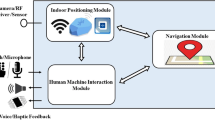Abstract
This paperpresents the performance evaluation of a portable digital radiophoneinfluencedby the operator's body in urban mobile environments, based on the EVM (errorvector magnitude) and BER (bit error rate) simulation. The type of digitalmodulation follows to the NADC-TDMA standard. A new probability densityfunction(pdf) is proposed to describe the statistic of the EVM in an AWGNchannelunder frequency non-selective slowly fading situation. The simulation combinesthe modified Doppler power spectrum (MDPS) method and a gray coding(π/4-DQPSK modulation with square-root raised cosine (SRRC) shaping filter.The performance evaluation based on BER uses an ideal matched-filter-basedreceiver. The results show that the closer of the distance between theradiophone antenna and the operator's head, the poorer of the EVM and BERperformance.
Similar content being viewed by others
References
R. Hassum, M. Flaherty, R. Matreci and M. Taylor, “Effective Evaluation of Link Quality Using Error Vector Magnitude Technique”, in Proc. IEEE Wireless Commun. Conf., pp. 89–94, 1997.
K. Voelker, “Apply Error Vector Measurements in Communications Design”, Microwave and RF, pp. 143–152, 1995.
S. Chennakeshu and G.J. Saulnier, “Differential Detection of π/4-Shifted-DQPSK for Digital Cellular Radio”, IEEE Trans. Veh. Tech., Vol. VT-42, No. 1, pp. 46–57, 1993.
L.E. Larson (eds), RF and Microwave Circuit Design for Wireless Communications, Artech House, 1996.
F.L. Lin and H.-R. Chuang, “Performance Evaluation of a Portable Radio Close to the Operator's Body in Urban Mobile Environments”, IEEE Trans. Veh. Tech., Vol. 49, No. 2, pp. 614–621, 2000.
W.C. Jakes, Jr., Microwave Mobile Communications, Wiley and Sons: New York, 1974.
G.F. Pedersen, S. Widell and T. Ostervall, “Handheld Antenna Diversity Evaluation in a DCS-1800 Small Cell”, in Proc. PIMRC 1997, Helsinki, pp. 584–588.
J. Toftgard, S.N. Hornsleth and J.B. Andersen, “Effects on Portable Antennas of the Presence of a Person”, IEEE Trans. Antennas Propagat., Vol. AP-41, No. 6, pp. 739–746, 1993.
H.-R. Chuang, “Human Operator Coupling Effects on Radiation Characteristics of a Portable Communication Dipole Antenna”, IEEE Trans. Antennas Propagat., Vol. AP-42, No. 4, pp. 556–560, 1994.
M.A. Jensen and Y. Rahmat-Samii, “Performance Analysis of Antennas for Handheld Transceivers Using FDTD Antennas”, IEEE Trans. Antennas Propagat., Vol. AP-41, No. 6, pp. 739–746, 1993.
M. Patzold, U. Killat and F. Laue, “A Deterministic Digital Simulation Model for Suzuki Processes with Application to a Shadowed Rayleigh Land Mobile Radio Channel”, IEEE Trans. Veh. Tech., Vol. VT-45, No. 2, pp. 318–331, 1996.
J. Proakies, Digital Communications, McGraw-Hill: New York, 1989. EVM and BER Simulation of an NADC-TDMA Radiophone
Author information
Authors and Affiliations
Rights and permissions
About this article
Cite this article
Lin, FL., Chuang, HR. EVM and BER Simulation of an NADC-TDMA Radiophone Influenced by the Operator's Body in Urban Mobile Environments. Wireless Personal Communications 17, 135–147 (2001). https://doi.org/10.1023/A:1008950527476
Issue Date:
DOI: https://doi.org/10.1023/A:1008950527476




